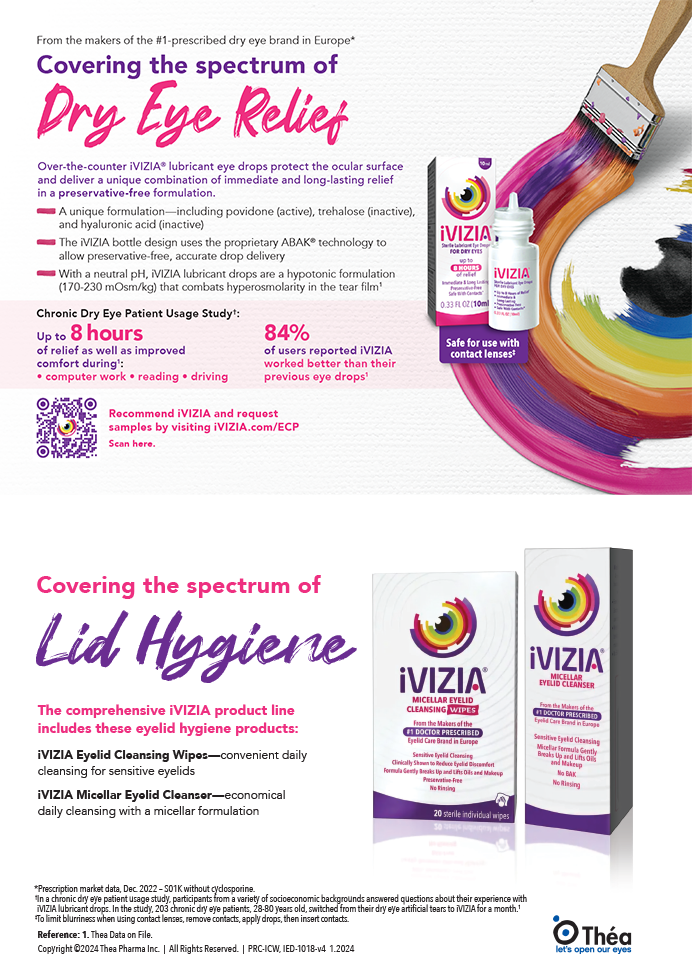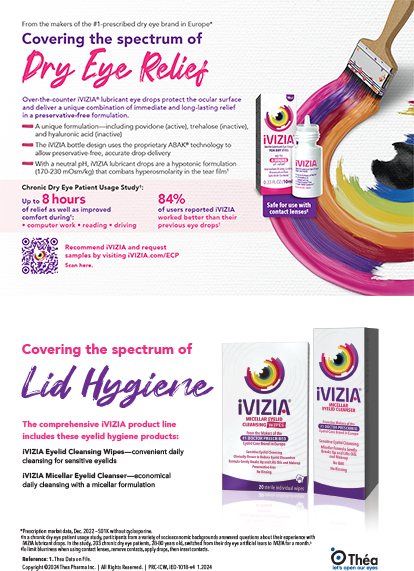Visually significant cataracts can develop in eyes that have previously undergone corneal transplantation (penetrating keratoplasty [PKP] or deep anterior lamellar keratoplasty [DALK]). The incidence is thought to be nearly 25%, with most patients developing some degree of nuclear or cortical cataract within the first 5 years.1 Steroid use in the postoperative period and intraoperative iris manipulation can contribute to the development of cataracts. Additionally, if the initial corneal pathology was related to infectious keratitis with intraocular inflammation or a full-thickness corneal laceration, the incidence of developing significant cataracts in the first year after surgery is higher.1
BACKGROUND
In a multivariate analysis of risk factors for developing cataracts after PKP, patients who were 50 years of age or older had a higher chance of developing visually significant cataracts within 5 years of undergoing PKP than their younger cohorts.2 Limited data are available on patients who have undergone DALK, but the presumption is that the incidence may be lower, given that DALK is a closed-system surgery as opposed to an open-sky procedure. Additionally, post-DALK eyes tend to require a shorter course of steroids, a potential reason for a lower rate of related cataract formation. Lastly, the underlying pathology leading to the decision to offer DALK includes noninflammatory conditions such as keratoconus, which are independently associated with a lower chance of cataract formation and often occur in the younger subgroup of patients.
In eyes with previous PKP that develop visually significant cataracts, cataract extraction can be performed safely with some caveats. Surgeons should consider five main factors when modifying their decision making and technique: (1) the timing of cataract surgery, (2) IOL calculations, (3) wound construction, (4) corneal endothelial protection, and (5) postoperative management.
Cataract Surgery AFTER PKP
Timing
The decision to proceed with cataract surgery is
guided by the visual deterioration caused by the
cataracts. The best timing for surgery is a subject of
debate and is often determined by clinical findings,
surgeons' preferences, and patients' expectations. Ideally, cataract surgery in an eye with a history of
PKP is performed after the penetrating corneal wound
is stable and the keratometry readings are reliable.
This may mean waiting at least 6 months and selectively
or completely removing sutures to allow for an
optimized and stable corneal curvature. I would also
suggest ensuring reliable and stable corneal measurements
at two sequential visits 3 to 6 weeks apart. To
further ensure the stability of these measurements,
the surgeon must also address any tear film instability
and ocular surface disease.
IOL Calculations and Choice of Implant
As mentioned previously, the ideal situation is one
in which the corneal power measurements (both average
keratometry and cylinder) used in determining
the IOL's power are stable, allowing for the most predictable
refractive outcome. This can be addressed in
one of three ways. When the corneal cylinder is high
and/or irregular based on corneal topography, astigmatism
can be managed sequentially, first with astigmatic
keratotomy and then later by cataract extraction
and IOL implantation when the corneal power
has stabilized. Although this approach may lead to
a more predictable refractive outcome, the delayed
visual recovery is not always acceptable to the patient.
An alternate approach is to perform astigmatic keratotomy
at the time of cataract extraction and IOL
implantation. When corneal astigmatism is regular
and less than 4.00 D as noted on corneal topography,
cataract extraction can be performed and a toric IOL
implanted.
Wound Construction
A standard clear corneal incision is often possible in an
eye that has had PKP but, again, with a few caveats. In eyes
with remaining pathology in the recipient corneal rim
(eg, pellucid marginal degeneration), the integrity of the
wound may be compromised, and apposition of the
wound's edges is unlikely. In such a setting, I consider a
limbal or a scleral incision. In an eye undergoing cataract
surgery that has a large PKP graft, which may leave little
room for a well-constructed clear corneal incision, the surgeon
should consider a scleral tunnel to avoid disrupting
the graft-host junction. Finally, if a clear corneal incision is
used, the surgeon should have a lower threshold for placing
a safety suture, because the contour of the cornea in an eye
after PKP may more frequently lead to wound leakage.
Corneal Endothelial Protection
Endothelial cell loss occurs at a higher rate in post-
PKP eyes after cataract surgery. Surgeons must therefore
take extra precautions during surgery to protect
the fragile endothelial cell layer. Obviously, the generous
use of viscoelastic—ideally dispersive—to protect
the endothelial cell layer during phacoemulsification
of the phakic lens will help protect against damage.
Minimizing phaco power with updated settings that
allow more efficient use of the energy also helps.
Perioperative Management
The more frequent perioperative use of steroids
is thought to lessen the inflammatory response to
surgery, which could initiate a rejection episode. The
patient can be asked to start a steroid regimen prior
to surgery and to continue dosing four to six times a
day for several weeks until all inflammation subsides.
CONCLUSION
Cataract surgery in an eye that has undergone PKP can be safely performed with a few modifications in surgical planning and technique.
Neda Shamie, MD, is an associate professor of ophthalmology at the Doheny Eye Institute, University of Southern California Keck School of Medicine, and the medical director at the University of Southern California Doheny Eye Center-Beverly Hills. Dr. Shamie may be reached at nshamie@doheny.org.
- Rhathi VM, Krishnamachary M, Gupta S. Cataract formation after penetrating keratoplasty. J Cataract Refract Surg. 1997;23(4):562-564.
- Martin TP, Reed JW, Lagault C, et al. Cataract formation and cataract extraction after penetrating keratoplasty. Ophthalmology. 1994;101(1):113-119.


